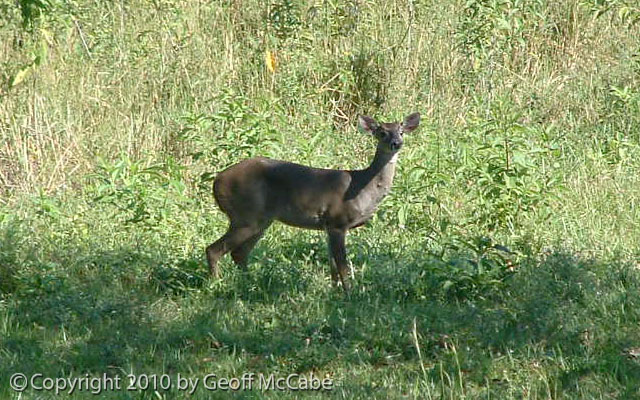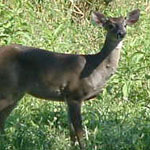- Home
- Accommodation
- Activities
- Area Info
- Maps
- Photo Galleries
- Real Estate
- Travel
Deer
Height/Weight: The largest species of deer is the Moose that is 5-7 ft tall and weighs around 800-1500 lbs. The smallest species of deer is the Pudu. It is 13-17 inches long and weighs 32lbs. The White Tailed Deer varies in size.
Average life span: They average life span of a white tailed deer is 7-10 years. They rarely live more than 10 years but there have been cases of 20 year old deer.
Habitat: They mainly live in wooded areas, pine forests, swamp lands, and plain areas while some others survive in moderate rain forests and deserts. The deer can adapt to a wide variety of habitats.
 The white-tailed deer is the smallest member of the North American deer family member. They are usually found from southern part of Canada to Southern America. During the summer season, they generally inhabit fields using abundant leaved and wooded forests for shade. However, come winters and they usually stick to forests, preferring coniferous forests that provide shelter from the cold harsh weather. White tailed deer are widely spotted all around large the Central American terrain. They are regularly seen in the tropical Guanacaste’s tropical rainforests. They can also be seen in the natural reserves and national parks of the country. It is so extensively spotted in Costa Rica that the white tailed or Virginia deer is the national symbol of Costa Rica and represents the country’s rich and diverse ecologically.
The white-tailed deer is the smallest member of the North American deer family member. They are usually found from southern part of Canada to Southern America. During the summer season, they generally inhabit fields using abundant leaved and wooded forests for shade. However, come winters and they usually stick to forests, preferring coniferous forests that provide shelter from the cold harsh weather. White tailed deer are widely spotted all around large the Central American terrain. They are regularly seen in the tropical Guanacaste’s tropical rainforests. They can also be seen in the natural reserves and national parks of the country. It is so extensively spotted in Costa Rica that the white tailed or Virginia deer is the national symbol of Costa Rica and represents the country’s rich and diverse ecologically.
The white tailed deer is seen in the wooded areas of Costa Rica including pine forests, swamp lands, and plain areas while others exist in temperate rain forests and also desert regions. Deer can survive in a variety of habitats. The deer can live on a range of less than a single square mile. These are generally solitary creatures but when the mother has her fawns, they all live in a group and move together until the young ones are big enough to move around on their own. Bucks (male deer) will usually move about in groups of 4-5, however this pattern is broken during the mating season when they go solo in search of a mate.
 The white-tailed deer are herbivores mammals and is a ruminant (it has a four-chambered stomach) like a cow. These creatures live on a huge variety of food, usually comprising legumes and many types of plants, including leaves, mushrooms, plant shoots, cactus, berries and grasses.
The white-tailed deer are herbivores mammals and is a ruminant (it has a four-chambered stomach) like a cow. These creatures live on a huge variety of food, usually comprising legumes and many types of plants, including leaves, mushrooms, plant shoots, cactus, berries and grasses.
Come breeding season and the males will attempt to mate with several females at a time. If there are plenty of males in an area, there will be a fierce fight for the females which can lead to injury. Female deer give birth to 1-3 young ones at a time, usually in May or June. Fawns are rid of their dots by summer. Along with the mother, they will form groups of two to six individuals, though some groups are known to have as many as 15 members. The white tailed deer is a very good runner and leaper. When they sense danger, they will stamp their hooves on the ground and make a loud grunt like sound to warn other members about the impeding danger.
The white-tailed deer is known to eat a wide variety of foods. They forage on plants, eating different parts of a plant. They will also eat corn with great delight. The white-tail dear has a special stomach which allows it to digest certain parts of plants that are fatal for humans. The whitetail deer develops flexible eating habits and is able to digest a variety of foods owing to the huge range of environment it survives in. It also has a special genesis of bacteria in its stomach that adapts with the changing weather, enabling the whitetail deer to digest the different kinds of foods during different climatic conditions.
The whitetail deer has been widely hunted and this, along with encroachment and subsequent deforestation has caused its population to plummet. This has translated into serious conservation efforts which have been successful enough to take their population to more than 30 million. The flipside of this now is that owing to the lack of predators the deer population has grown so much that it is now causing trouble to farmers and destruction of crops.
More Information
http://www.travelcostarica.nu/mammals
http://www.costaricajourneys.com/deer-white-tailed-deer-of-costa-rica/
http://www.infocostarica.com/fauna/mammals.html
Great Stuff

Clandestina Restaurant
My new favorite restaurant, Clandestina is not to be missed by food lovers staying anywhere near to Montezuma. Established in March 2015, Clandestina is the new kid on the block. The Oregon/Tico collaboration is a winner among locals and travelers alike, with artisan craft beers, made onsite by Butterfly Brewing Co. and delicious, exciting […]











